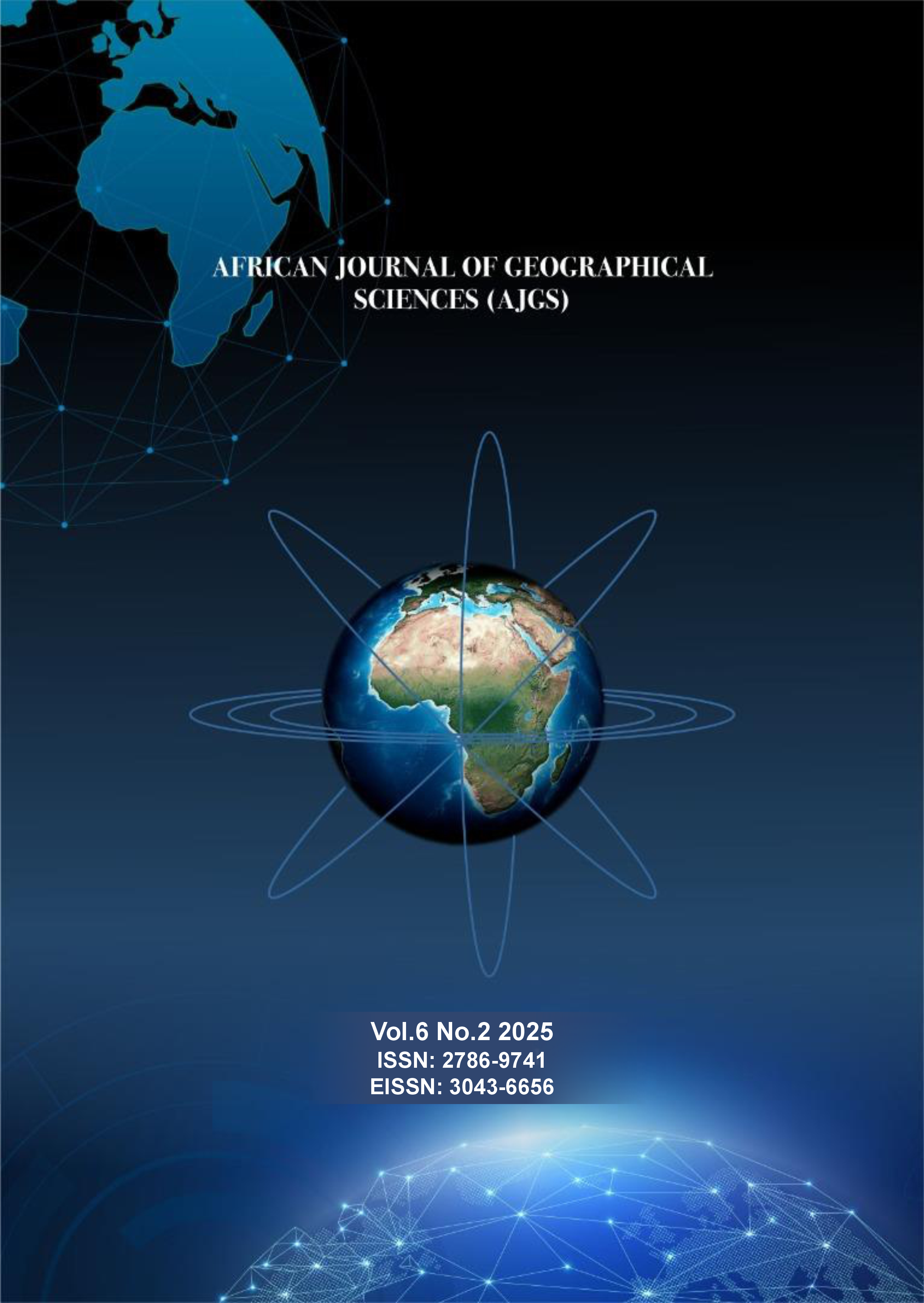IMPACT OF ARBUSCULAR MYCORRHIZAL FUNGI ON ROOT CALCIUM CONTENT OF COWPEA VARIETIES (Vigna unguiculata L. WALP) UNDER ALECTRA VOGELII INOCULATED SOIL
Contenu principal de l'article
Résumé
Biological control methods can play an important role in managing plant parasites affecting cowpea production particularly in the face of climate change. This research evaluated the effect of Glomus clarum on the root calcium content of four cowpea varieties in an Alectra vogelii inoculated soil. The four cowpea varieties used were: SAMPEA 7, IFE 82-12, IT97K-499-35 and TVX 3236. The sterilized sandy-loamy soil used for this experiment consisted of a mixture of top soil and sand in ratio 1:1 (v/v). Glomus clarum treatments was applied at five rates: the zero and without Alectra, zero and with Alectra, 10, 20 and 30 g/pot each with Alectra (3.3 g). The treatments were arranged in complete randomized design. The root of cowpea plants was sampled for calcium content at 5 weeks after planting (WAP). Testing with ANOVA, the two years data based on Glomus clarum treatments, the Glomus clarum at 30 g/pot treatment resulted in highest root calcium content which was only comparable with that due to 20 g/pot Glomus clarum treatment. In addition, Glomus clarum treatments resulted in the highest root calcium content in IT97K – 499 – 35 which was only significantly higher than the lowest root calcium content observed in TVX 3236. In conclusion, Glomus clarum treatments significantly increased root calcium content for the cowpea varieties on Alectra inoculated soil and thus recommended as a biological control agent in Alectra vogelii infested fields.
Details de l'article
Références
Balliu, A., Sallaku, G. and Rewald, B. (2015) AMF inoculation enhances growth and improves the nutrient uptake rates of transplanted, salt stressed tomato seedlings. Sustainability 7:15967 – 15981.
Black, C.A. (ed) (1665). Methods of soil analysis. Agronomy: 9: 2 Amer Soc Agronomy, Madison, Wisconsin.
Brink, M. and Belay G, (2006). Plant resources of topical Africa 1: Cereals and Pulses. Prota Foundation/Backhoys published/CTA Wageningen, pp.129-133.
Chen. S., Zhao, H., Zou, C., Li Y., Chen, Y., Wang, Z., et al. (2017). Combined inoculation with multiple arbuscular mycorrhizal fungi improves growth, nutrient uptake and photosynthesis in cucumber seedlings. Front microbiology 8: 16 – 25.
Food and Agricultural Organization (FAO)/ World Food programme (WFP) (2010). The State of Food Insecurity in the world: Addressing food insecurity in protracted crises. Food and Agricultural Organization, Rome.
Gemma, J. N. and Koske, R. E. (1988). Seasonal variation in spore abundance and dormancy of Gigaspora gigantea and in mycorrhizal inoculum potential of a Dune soil. Mycology, 80: 211 – 216.
Heckman, J.R. and Angle, J.S. (1987) Variation between soyabean cultures in Vesicular-arbuscular mycorrhiza fungi colonization. Agronomy of Environmental Quality Vol 16(2):113-117
Heimpel, G. E. and Mills, N. J. (2017). Biological Control: Ecology and Applications. Cambridge University Press, Cambridge.
Jackson, M.L. (1962). Soil chemical. Prentice Hall, New York.
Karanja., J. K.., Nguluu, S. N., Wambua, J., Gatheru, M. (2013). Response of cowpea genotype to Alectra vogelii parasitism in Kenja. African Journal of Biotechnology, 12: 6591-6598.
Karungi, J., Adipala, E., Ogenya – Latego, M. W., Kwamanywa, S., Oyobo, N. and Jackai, L. E. N. (2000). Pest management in cowpea. Part 2. Integrating planting time, plant density and insecticide application for management of cowpea field insect pest in Eastern Uganda. Crop Protection, 19: 237 – 245.
Katalin, P. and Nguyen, H.D. (2019). Benefits of arbuscular mycorrhiza fungi application to crop production under water scarcity https://www.intechopen.com/online-first/benfits-of arbuscular-mycorrhiza-fungi-spplication-to-crop-production-under-water-scarcity#B12.
Katuma, A. S., Hayatu, M., Umar, S. (2013). Effect of Alectra vogelii (Benth) infestation on the growth of some genotypes of Cowpea (Vigna unguiculata L. Walp). Standard Research Journal of Agricultural Science, 2:33-29.
Lawes Agricultural Trust (1980). Genstat Manual Release 4.03, Ms_DOS version by C.E.M.S (J.C. and Y.M) Rotihamsted Experimental Station.
Lebron, L., Lodge, D.J. and Bayman, P. (2012). Differences in arbuscular mycorrhizal fungi among three coffee cultures in Puerto Rico. ISRN Agronomy (2). DO1:10.5402/2012/148042.
Lydia, N. H., Selma, N. N., Ueitele, I. (2022). Cowpea Production Challenges and Contribution to Livelihood in Sub-Saharan Region. Agricultural Sciences, Vol 13: 25-32.
Mbwaga, A., Hella, J., Mligo, J., Kabambe, V., Bokos, J. (2010). Development and promotion of Alectra resistant cowpea cultivars for small holder farmers in Malawi and Tanzania. McKnight Foundation Collaborative Crops Research project No : 06741.
Mengel, K. and Kirkby, E. (2006). Principles of plant nutrition 5th ed. Khiwer Academic Publishers, London.
Mitra, D., Uniyal, N., Panneerselvam, P., Senapati, A. and Ganeshamurthy, P. (2019). Role of mycorrhiza and its associated bacteria on plant growth promotion and nutrient management in sustainable agriculture. Int. J. Life. Sci. Applied. Sci., 1:1-10.
Musango, R., Pasipanodya, J.T., Tamado, T., Mabasa, S. and Makaza W. (2022). Alectra vogelii: a threat to Bambara groundnut production under climate change: a Review Paper. Journal of Agricultural Chemistry and Environment, 11(2):83-105
Narayana M. and Angamuthu M. (2021). The Beans and the Peas. Woodhead publishing. Pp 241-272
Roldan-Fajardo, B.E (1994). Effect of indigenous arbuscular mycorrhizal endophytes on the development of six wild plants colonizing a semi-arid area in south-east Spain. https//doii.org/10.1111/j.1469-8137.19994,tbo4265.X.
Uwammungu, J. Y., Shi, G., Wang, Y., Paliwal, A., Jadhav, r. R., and Wani, A. W. (2022). Arbuscular mycorrhizal fungi (AMF) for sustainable soil and plant health In Microbial and Biotechnological Interventions in Bioremediation and Phytoremediation. Cham Springer International publishing. Pp 135-152
Wahab, A., Muhammad M., Munir A., Adbi G., Zaman, W., Ayaz, A., Khizar C., Reddy S.P.P (2023). Role of Arbuscular Mycorrhizal Fungi in regulating growth, enhancing productivity, and potentially influencing ecosystems under Abiotic and biotic stresses. Plants (Basel):12 (17):3102.
